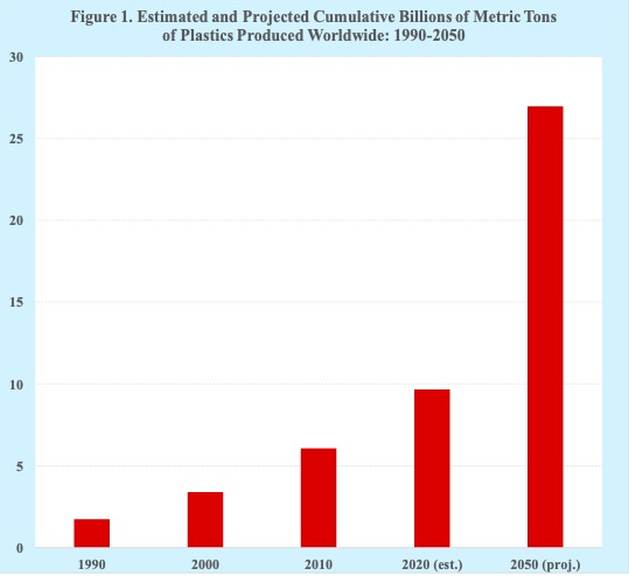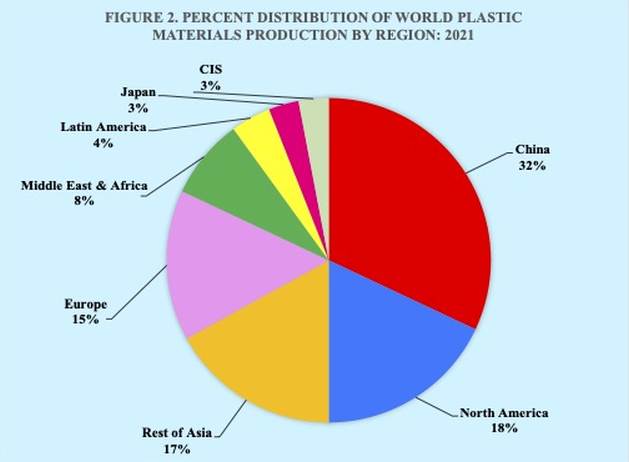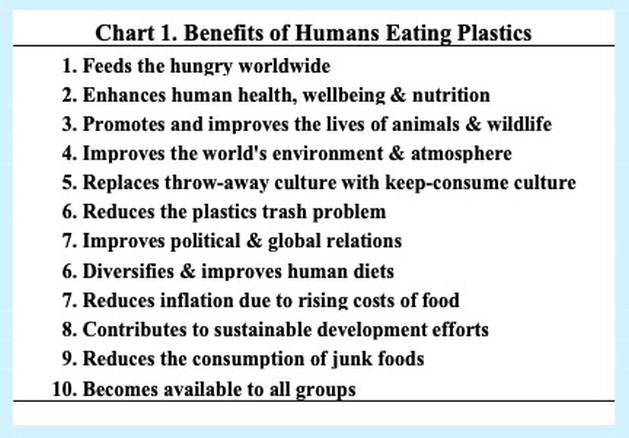Let’s Eat Plastics!

PORTLAND, USA, Feb 13 (IPS) - With one in ten people in the world going hungry, food prices hitting record highs, and the worsening conditions of the environment and climate, it’s time for the world’s population of 8 billion to eat something that is available, abundant and inexpensive: plastics.
Their introduction at the start of the 20th century began the rapid start of the Age of Plastics. Today plastics are ubiquitous, easily transported and stored, and readily available even in the most remote corners of the world.
Plastics have become such an integral part of human daily life from birth to death, completely infiltrating the environment of planet Earth. Plastics can be found anywhere, including in water, on land and even in the atmosphere
Every year the world produces approximately 400 million metric tons of plastics. That amounts to about 50 kilograms of plastics, or 110 pounds, for each person on the planet.
Today’s annual amount of plastics produced could certainly be increased. With the proper political commitment, private investments and improved technologies, the annual production of plastics could be greatly expanded.
A tenfold increase in the annual production of plastics would yield no less than 500 kilograms, or 1,100 pounds, of a variety of plastics for every man, woman and child on the planet. That would provide an individual daily consumption of 1.4 kilograms, or 3 pounds, from a broad diversity of plastics, which is approximately the amount of food people eat each day.
In addition, the cumulative amount of plastics that has already been produced worldwide is estimated at approximately 10 billion metric tons. That vast valuable global resource yields about 1,250 kilograms, or 2,756 pounds, for each man, woman and child now inhabiting planet Earth. Moreover, the world’s cumulative amount of plastics is projected to nearly triple by midcentury to about 27 billion metric tons (Figure 1).

Eating plastics would solve the world’s hunger problem for hundreds of millions of people as well as offer numerous other advantages. Plastics could be used as a feed supplement for farm animals, especially for pigs but also for cattle, sheep, goats, chickens, etc., as well as a supplemental food for fish and other aquatic wildlife, many of which are already eating plastics.
It’s highly unlikely that people will voluntarily agree to cutbacks in their current use of plastics. Eating plastics would also largely eliminate the costly, ineffective and bothersome process of asking people to recycle their plastics.
Cost is the primary reason why less than a tenth of plastics produced annually are recycled. For the plastics industries the costs of recycling are far greater than the costs of producing new plastics.
Instead of today’s problematic plastic throw-away culture, eating plastics would foster a “keep-consume” culture. Such a cultural transformation to keep-consume plastics would certainly be welcomed by people around the world.
A keep-consume plastics culture would be environmentally sound, cost effective and economically sustainable. Rather than having more than 10 million metric tons of plastics dumped in the oceans annually, humans could simply eat their plastics in the comfort of their homes. Human and livestock consumption of plastics would keep the oceans clean and reduce pollution. Plastics that accidently enter the oceans can be consumed by fish and other wildlife.
In 2021 about one third of the global plastic materials was produced by China. It was then followed by North America, the rest of Asia and Europe 18, 17 and 15 percent, respectively. Substantially lower in the production of plastics with each less than 10 percent were the rest of the regions (Figure 2).

Attempting to eliminate the production of plastics is clearly impractical and costly. The elimination or even the serious reduction in the production of plastics would undermine national economies, increase unemployment, reduce wages, raise poverty rates and fuel political instability. Consequently, eating plastics at every meal should be promoted in schools, workplaces, places of worship, recreation facilities, retirement centers, homes, etc.
Most plastics are generally not biodegradable. They will not spoil and are not perishable like traditional foods and therefore have a long shelf life, taking anywhere from 20 to 500 years to breakdown, if at all.
Plastics breakdown depends on the material’s composition, structure and environmental factors, such as exposure to sunlight. In the oceans, for example, plastics straws and plastic water bottles are estimated to breakdown in 200 and 450 years, respectively.
The plastics remaining in the environment often break down into microplastics, which are small pieces of plastics including fibers, microbeads, fragments, nurdles, and foam. Those microplastics are already found in water, food and some animals. Given their diversity of shape, texture and color, microplastics can be readily consumed by men, women and even older children, but in small amounts initially.
Plastics could enhance traditional dishes, such as chicken plastic masala, microplastics pizza, kung plastic pao chicken, plastic burger, croque plastic-monsieur and shepherds’ plastic pie. Microplastics could also be used as a spice, food additive or culinary enrichment to enhance daily meals, similar to the current practice of adding salt and pepper to meals.
Without knowing it, people are already consuming microplastics. The largest source of microplastics in people’s diet is drinking water. Microplastics can also be found in vegetables, fruits, meats, fish, tea, beer, wine, etc.
Some have estimated that on average a person might be consuming 5 grams of microplastics per week, amounting to approximately 18 kilograms, or 40 pounds, of plastic over a lifetime. Human autopsies have also found microplastics in major human organs, such as lungs, liver, spleen, and kidney tissue.
On the plus side, people eating plastics reduces the feeling of hunger, cuts down on calories and helps with weight loss. Also, it fills the stomach of birds, fish and other small animals.
Human consumption of plastics also addresses concerns of countries regarding the problems resulting from plastics. Rather than banning the use of plastic bags for bagging groceries, governments could encourage their citizens to eat their plastic bags at their daily meals.
People eating plastics also helps to eliminate the plastics trash problem, reduces pollution in waterways, landfills and atmosphere, and contributes to the achievement of the 17 Sustainable Development Goals adopted by United Nations Member States. Eating plastics will also improve the world’s environment, atmosphere and wildlife, reduce the consumption of unhealthy junk food and help reduce inflation due to the rising costs of traditional foods (Table 1).

As is case with innovation, it will take some time for people to become accustomed to eating plastics. This will especially be the case among older cohorts of people who are less willing than younger cohorts to accept innovation, new technologies and new cultural behavior.
Admittedly, some concerns have been expressed by health professionals and scientists about eating of plastics, given that they are being made mostly from fossil fuels, i.e., oil and natural gas, through a process that is energy intensive and emits greenhouse gases. Those health concerns include endocrine disrupting chemicals, which are linked to infertility, obesity, diabetes, prostate or breast cancer, and cognitive impairment and neurodevelopmental disorders.
However, such health concerns and exaggerated warnings are limited to scientific research and not from the producers of plastics. The technical research findings are understood largely by scientists, but mainstream media as usual has publicized the warnings about eating plastics.
People’s bodies will evolve to the consumption of plastics. That evolutionary process will be similar to people eating processed junk foods. But like junk foods, infants should not consume microplastics and young children should limit their consumption.
Eating plastics will require more mindful chewing of most plastics. Some may be tempted to simply swallow plastics. However, except for microplastics, it is not recommended for proper digestion.
Those with existing health problems may encounter reactions to eating plastics. Such reactions can be addressed by eating small amounts of plastics initially and drinking plenty of fluids, especially alcoholic beverages. Those fluids will aid in digestion and permit the body’s vital organs to evolve.
In sum, to address widespread hunger in the world, the high and rising costs of food, and the consequences of plastics on the environment, flora, fauna and climate, the solution is clear. Let’s eat plastics!
Joseph Chamie is a consulting demographer, a former director of the United Nations Population Division and author of numerous publications on population issues, including his recent book, "Population Levels, Trends, and Differentials".
© Inter Press Service (2023) — All Rights Reserved. Original source: Inter Press Service
 Global Issues
Global Issues